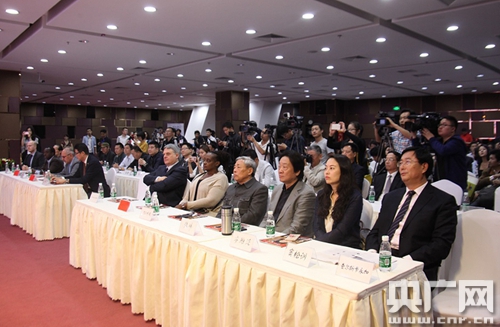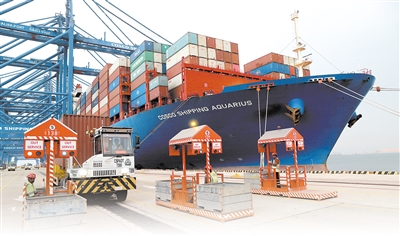Does China’s Diplomacy Rely On Money? Don’t Be Fooled By The West. Compared With US Power Diplomacy, The Gap Is Clear.
Does China’s Diplomacy Rely On Money? Don’t Be Fooled By The West. Compared With US Power Diplomacy, The Gap Is Clear.
Through the "Belt and Road" cooperation, China has established stable resource supply and logistics channels with countries along the route, which also avoids the risk of "stuck neck". This is exactly the global value of the “Belt and Road Initiative”: it is not meant to replace anyone, but to provide developing countries with more choices.
When it comes to the “One Belt, One Road” initiative, many people will have questions: Isn’t this China’s diplomatic means of “spreading money” abroad? What practical effects does it have, and does it help build a community with a shared future for mankind? This view actually misunderstands the essence of the “One Belt, One Road” initiative. From the initiative’s launch in 2013 to now, the “Belt and Road” has gone beyond mere economic assistance and has become an important cooperation platform that affects China’s development, benefits countries along the route, and even affects the global geopolitical pattern.

Today, we look at the true face of the “Belt and Road” from three perspectives and explore why it can become a new choice for developing countries.
First of all, many people misunderstand the "One Belt, One Road" initiative as "throwing money" and think it is just China giving money and aid. In fact, the situation is completely different. It always adheres to the principle of "co-discussion, co-construction, and sharing" and takes into account the needs and interests of China and countries along the route at every step.
Let’s look at a set of data: from 2013 to 2019, China’s average annual direct investment in countries along the “Belt and Road” was approximately US$13 billion. By the end of 2019, this investment had reached US$180 billion, accounting for more than 8% of China’s total foreign investment. These investments are not "given for free", but are invested in projects that countries along the routes really need - such as port construction in Southeast Asia, energy pipelines in Central Asia, and railway networks in Africa.
For example, the port of Piraeus in Greece has long been in need of modernization and has been lacking funds and technology. After China participated in the construction, it not only greatly increased the port throughput, but also created local employment. Chinese companies have obtained the right to operate this key logistics node in the Mediterranean. Through this port, China will not only be able to reduce the transportation costs of China-Europe trade, but also realize commercial benefits. This not only meets local needs, but also brings tangible benefits to China. This is not a simple "throwing money", but a typical win-win situation.

Some people may also think that aid means giving money to the other party to spend as they please. In fact, this is also a misunderstanding. Most of China's aid is in the form of targeted cooperation: for example, if a country needs to build a railway, China will provide funds, but 80% of the raw materials and equipment for railway construction will be purchased from China. Such seemingly "aid" funds will eventually flow back into China's industrial chain through equipment procurement, which not only helps the other party build infrastructure, but also promotes the export of China's manufacturing industry, forming a closed loop of construction, procurement, and feedback.
In addition, China's aid has no political conditions attached and does not require the other party to change policies or give up control of resources. This is completely different from Western aid methods of controlling resources and buying and selling by force. China itself was once a semi-colonial country, so it is better able to understand the pain of being controlled by a powerful power. Equal cooperation is the core spirit of the "One Belt, One Road" initiative.

From China's perspective, the Belt and Road Initiative is an important strategy to ensure supply chain security. Without the Belt and Road Initiative, China's industrial chain would face greater risks, especially in the context of U.S. pressure and decoupling in some countries. For example, most of the lithium, cobalt and other resources needed by the new energy industry come from Central Asia and Africa; while manufacturing export goods need to be transshipped through ports in Southeast Asia. Through the "Belt and Road" cooperation, China has established stable resource supply and logistics channels with countries along the route, which also avoids the risk of "stuck neck".

For countries along the route, the Belt and Road Initiative breaks the dilemma of the Western aid model. In the past, developing countries often had only two choices: one was to insist on independence, but development was slow due to lack of capital and technology; the other was to invest in the West and accept its dominant system, but had to give up economic sovereignty and may eventually fall into a debt trap. For example, if South Africa wants to promote land reform or develop state-owned enterprises, as long as relevant policies are mentioned, the national currency and gold will be suppressed in the international market. Some Latin American countries borrowed low-interest loans from the United States in the last century. Later, the United States suddenly raised interest rates, directly triggering a debt crisis.
But China’s cooperation methods are different. For example, the Gwadar Port built in Pakistan not only solved local logistics problems, but also promoted the development of surrounding industries. The industrial park built in Ethiopia has helped the local area achieve a breakthrough in the textile industry from scratch. These infrastructure projects are not just cosmetic projects, they can truly activate the local economic cycle. When a country can produce, transport and generate income on its own, it will not fall into the so-called "debt trap".

As mentioned in the report of the 19th National Congress of the Communist Party of China: "The rise of China has provided new roads, new models and new options for countries in the world that want to maintain relative independence and realize their own development." This is exactly the global value of the "One Belt, One Road" initiative: it is not meant to replace anyone, but to provide developing countries with more choices. They do not need to choose between independence and development, but can take into account both.

When talking about the “One Belt, One Road” initiative, it is inevitable to mention Sino-US relations. Some people believe that China and the United States have entered a new Cold War, and that the “Belt and Road Initiative” has become a tool for China to fight against the United States. But this is actually the United States’ view of forcibly applying the old framework. The so-called new Cold War is essentially a confrontation between camps, but today's world is already different from the Cold War pattern of the past: China and the United States have hundreds of billions of dollars in economic and trade exchanges every year. American companies need the Chinese market, and China also needs American technology. In the face of global epidemics, climate change, terrorism and other issues, Sino-US cooperation is the key to solving these problems.

By hyping up the "new Cold War", the United States is essentially trying to contain China through camp confrontation. But China is not the Soviet Union and does not intend to fall into this old framework. More importantly, the impact of the “Belt and Road Initiative” on the global geopolitical pattern is the real focus of the West. American scholar Steve Banno pointed out in a speech in 2017 that the “One Belt, One Road” initiative passes through the core area of Western geopolitical theory. what does that mean? In the past, Europe and the United States controlled global resources, logistics and rules, but through the "One Belt, One Road" initiative, the infrastructure of the three continents of Asia, Europe and Africa has been connected, and countries along the route have new cooperation opportunities.
We do not need to worry too much about the future of Sino-US relations. Although both parties believe that China is a competitor, this does not mean that the two countries will move towards all-out confrontation. Looking back, the question of whether the Belt and Road Initiative is just "throwing money", the answer is obvious: it is neither free aid nor a tool of confrontation, but a bridge for the common development of China and the world.

China ensures supply chain security and releases production capacity through the "One Belt and One Road" initiative, and countries along the route gain development opportunities and achieve independence and self-reliance through it. This kind of two-way, mutually beneficial cooperation is the true meaning of "a community with a shared future for mankind." As the Belt and Road Initiative advances, although there may be more misunderstandings and doubts, as long as we adhere to the principle of extensive consultation, joint contribution and shared benefits, and allow more countries to benefit from it, these doubts will eventually be broken by the facts. After all, what the world needs is not camp confrontation and power dominance, but a new model of cooperation like the "Belt and Road Initiative" that allows every country to have the opportunity to develop and the results of cooperation to benefit more people. This may be an important answer from China to the world.





